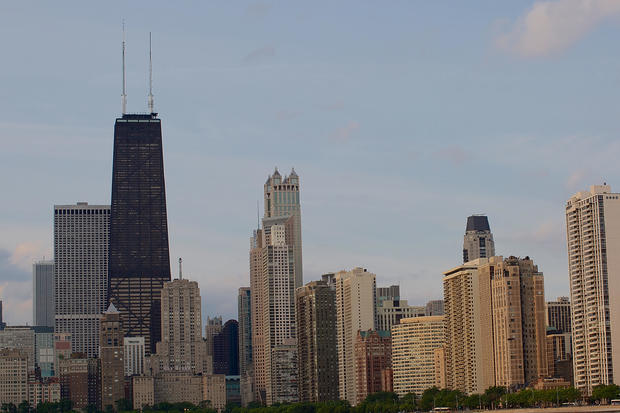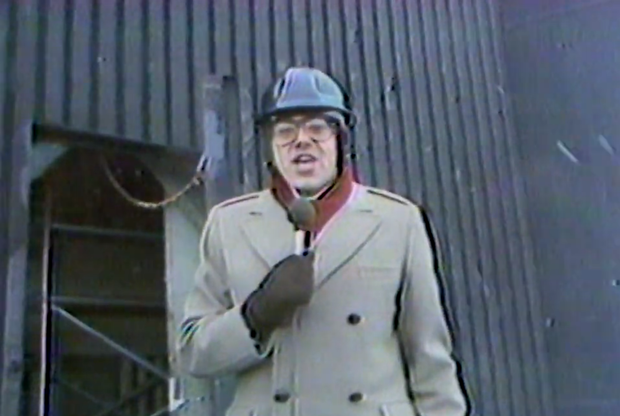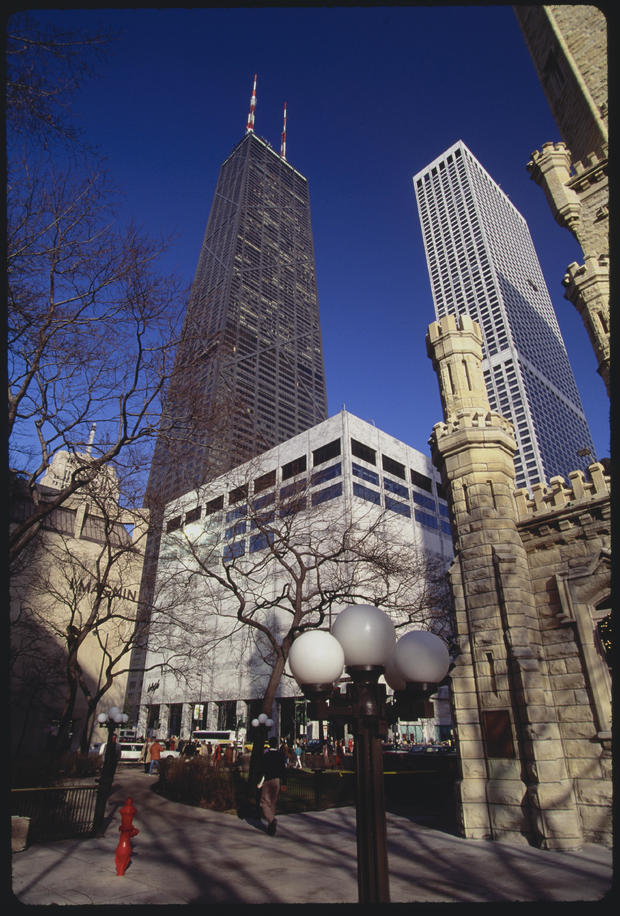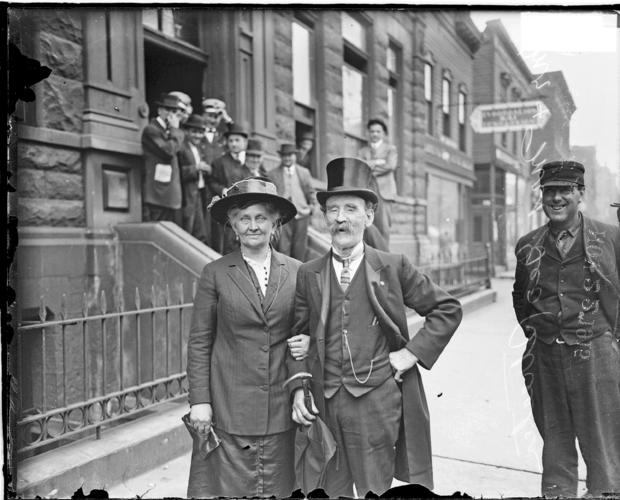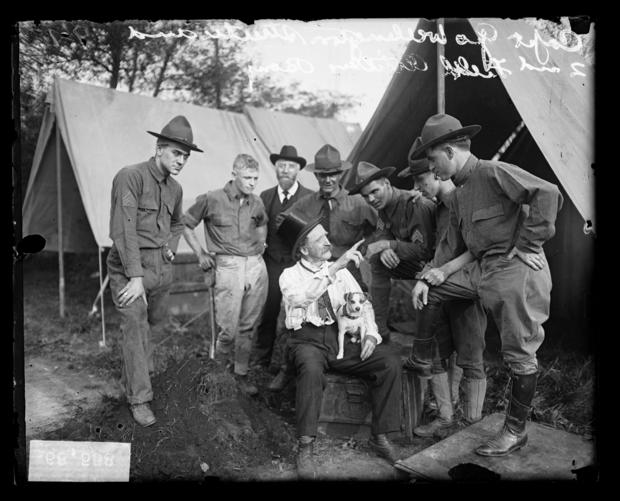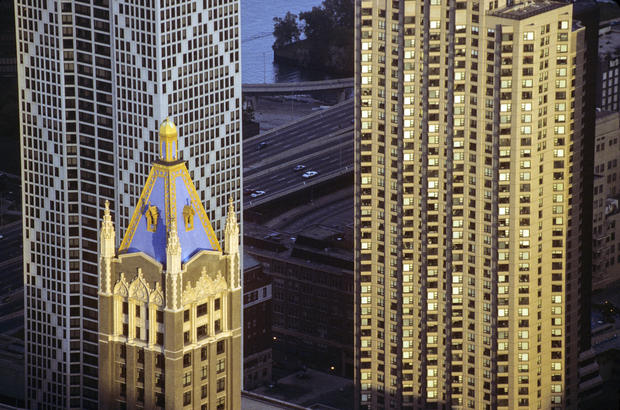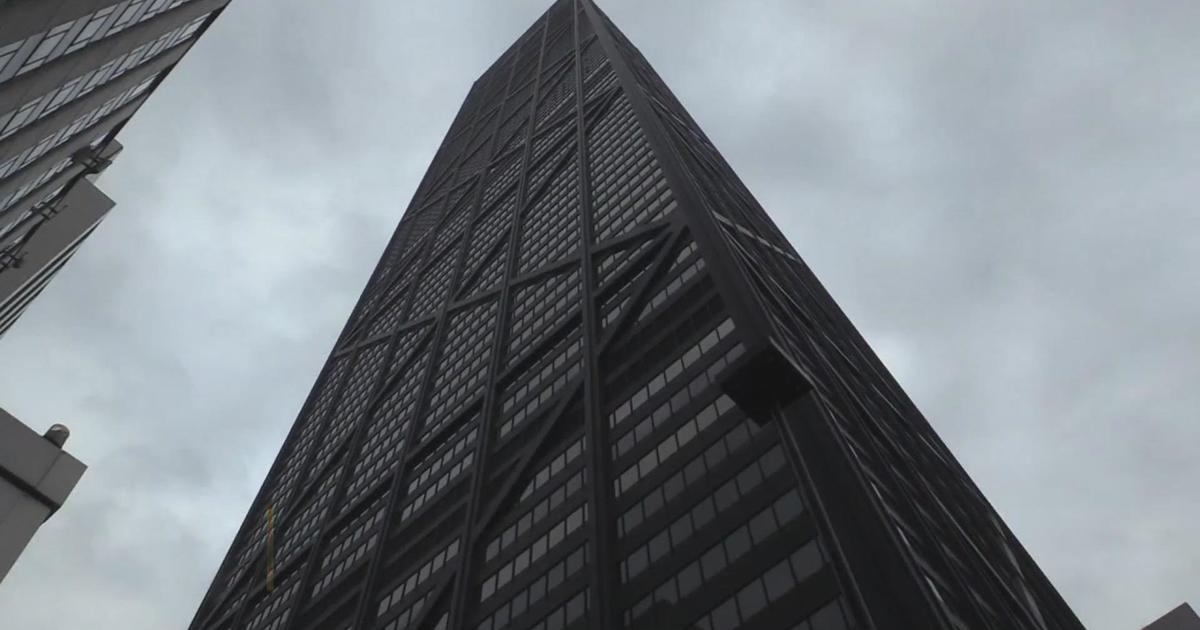Chicago Hauntings: Strange happenings at the former John Hancock and an old mariner's curse
CHICAGO (CBS) -- If you're from Chicago, you're sure to have a certain affection for the former John Hancock Center.
It's not officially called the John Hancock Center anymore – it's known by its address of 875 N. Michigan Ave. since John Hancock Financial withdrew its name from the skyscraper in 2018. But with no new name, the John Hancock is still commonly known by its old one. You might also have grown up calling it Big John.
As recounted by the website for the residential portion of the skyscraper, it was 1964 when developer Jerry Wolman – best known as the longtime owner of the Philadelphia Eagles and Flyers – first approached the architectural firm Skidmore, Owings & Merrill about a plan to develop a parking lot he owned on the Magnificent Mile between Delaware Place and Chestnut Street.
Wolman had envisioned two towers – one with apartments and the other with offices. But chief architect Bruce Graham and chief engineer Fazlur Khan came up with a design for one building with offices on the lower floors and apartments above, the building website notes. It was Khan who came up with the X-bracing on the outside of the trapezoidal tower, which eliminated the need for interior columns.
The John Hancock Center was completed in 1968 after three years of construction, and the first residents moved in the following year. The 100-story skyscraper measures 1,127 feet tall – at the time, it was dwarfed only by the Empire State Building in New York. The height tops out at 1,506 feet with the John Hancock's iconic twin broadcast towers – which were originally of the same height and candy-striped, but are now slightly mismatched and solid white.
You of course know the John Hancock as a crown jewel of the Chicago skyline and one of the most recognizable symbols of Chicago. In particular when looking south from DuSable Lake Shore Drive or a north lakefront beach, Big John proudly stands sentry in the foreground with the Water Tower Place stacked just behind it.
You have probably visited the 360 Chicago Observation Deck – formerly known as the John Hancock Observatory – with its breathtaking panoramic views and TILT thrill ride.
You may have had dinner at the Signature Room on the 95th floor for a special occasion like a college graduation – and if it was a Saturday night in the summer, you might have seen the fireworks at Navy Pier there from above. You probably have not been to the highest indoor swimming pool in America, but it's there on the 44th floor.
You have also no doubt seen the John Hancock on television – and for generations it was because of the John Hancock that you saw television at all. At one point in 1978, CBS 2 Health and Science Editor Roger Field demonstrated how television signals work by standing outside beneath the broadcast antenna towers on the roof of the skyscraper – in the snow.
We'll stick to the Signature Room, thanks.
But what you may not know is that Chicago ghost experts believe the John Hancock Center is Chicago's most haunted skyscraper – and is even subject to a curse. Tony Szabelski of Chicago Hauntings Ghost Tours says strange occurrences have been happening at the John Hancock ever since it first opened.
The first death most people point out to start this trend – and the first involving a plunge from the building – was that of Lorraine Kowalski. The 29-year-old woman plunged from her boyfriend's 90th-floor apartment at the John Hancock Center on Aug. 12, 1971.
A Chicago Tribune article from the following day described the gruesome details:
"A night watchman said he heard a crash from the upper floors as the woman broke through the 54-square inch double-pane window. He said he saw the naked woman fall, her body seemingly disintegrating as it bounced off the side of the building about halfway down."
Szabelski notes that the double-paned windows through which Kowalski broke were supposed to be able to withstand hundreds of pounds of pressure per square inch – between 200 and 400 depending on the source – before breaking. Kowalski was a slender woman, and many were shocked that she somehow built up the momentum to break through the window, Szabelski said.
And lest you think that's just a piece of folklore, the field engineer at the John Hancock was cited in that Tribune article from the very next day as being "amazed" that Kowalski had broken through the window.
Szabelski says Kowalski's ghost has been spotted around the building.
Ghost City Tours also notes that a local radio station employee fell to his death from the top of the building in 1975, and a student fell and died from the 91st floor a few months later. In 1978, a man who worked as an attorney downtown was shot and killed by a woman in a 65th-floor unit, according to published reports.
In 1988, the movie "Poltergeist III" was set at the John Hancock Center – and the skyscraper was also a primary location for filming. Heather O'Rourke – the child actress who played Carol Anne Freeling – died at the age of 12 during post-production for the movie. In fairness, O'Rourke did not die at the John Hancock Center – she died at Rady Children's Hospital in San Diego – and she had been sick and undergoing medical treatment since before filming began. But still – the whole story adds to the spooky factor.
And on Dec. 18, 1997, actor and comedian Chris Farley of "Saturday Night Live" fame died of a drug overdose in his 60th-floor condo at the John Hancock, at the age of 33.
In terms of hauntings, Szabelski says there are alarms that go off at the John Hancock for reasons unexplained, and he says several small fires have even broken out over the years without explanation.
The John Hancock also attracted attention from Anton LaVey – the founder of the Church of Satan. In his 1992 volume "The Devil's Notebook," LaVey introduced the Law of the Trapezoid in a philosophical treatise about how certain spatial configurations can cause "emotional imbalance and ensuing acts of violence." He focused in great depth on the perils of the trapezoid as a shape.
"The most disturbing shape of all is a trapezoid in its myriad forms. A perfect trapezoid is a frustrated pyramid. In fact, the place where a pyramid or triangle is lopped off to make a trapezoid is actually called the frustum. A trapezoid says to your unconscious, 'I am here, solid as can be, more massive than an ordinary block, but something's missing and it bothers you.' Of course, you know what's missing: a triangular top, like the one with an eye on the back of a dollar bill. Don't let that little pyramid with the bright eye fool you. That's to draw your attention away from the real thing: the big trapezoid beneath it. All competent magicians are masters of misdirection, and the Masons who designed the seal knew a thing or two."
In exploring that concept, LaVey wrote out a paragraph specifically about the trapezoidal John Hancock:
"The John Hancock Center in Chicago looms like a sentinel in its black splendor, its sloping sides and dark color presenting a brooding spectacle with its twin devil horns/antennae bisecting its top and continuing the frustum up and away into the sky. That its history is already grim is, to me, quite understandable."
LaVey also apparently claimed to have been born on the site where the John Hancock Center was later built, but author and historian Adam Selzer concludes this is likely not true. There was never a hospital on the site, and LaVey's family did not live anywhere near there when he was born in 1930 – they lived in Rogers Park.
One last spooky claim about the John Hancock involves spiders. Selzer notes the claim is that there is a huge migration of dangerous brown recluse spiders that climb the skyscraper every year. This is not actually true – at least not the brown recluse part. The spiders in question are actually a type of orb weaver spiders commonly known as bridge spiders or gray cross spiders, which work their way up tall buildings using their webs and can grow to the size of a 50-cent piece.
In a 2011 article conveniently published less than a week before Halloween, John Hancock Center broadcast facilities manager Mead Elliott told the Chicago-Sun Times the fall season was a "spider fest." Elliott went on:
"They are crawling everywhere, they are coming down on their strings everywhere, there are a lot of dead carcasses around -- it's like a haunted house. It's really weird seeing so many. You scratch your head, literally and figuratively."
An old mariner's curse?
So what is all this about a curse? Szabelski notes that ghost experts believe it might all have something to do with a well-known piece of strange Chicago history that dates back well before Big John was built.
Captain George Wellington Streeter was born in Flint, Michigan in 1837. As recounted in colorful prose in a 1976 edition of Chicago History magazine, Streeter served in the Union Army in the Civil War and then became something of a small-time P.T. Barnum, with "a menagerie of Michigan animals and birds" that were assembled for a wagon-drawn road show – also featuring "bunko and exotic carnival acts." After his first wife ran off with a vaudeville troupe, Cap Streeter ended up in Chicago in the 1880s and bought a half interest in a "tawdry" theater, the magazine reported.
Streeter and his second wife, Maria Mulholland, were advised by a drinking buddy that they could find success as gun runners in Honduras, the magazine reported. Streeter liked the idea, and he purchased and refurbished a steamboat, which he and his wife named the Reutan.
But they never made it to Honduras. Instead, the story goes that on the Reutan's maiden voyage to Milwaukee and back on July 10, 1886, the ship's boiler failed, and it ended up running aground on the shore of Lake Michigan. Most sources say the site was at about Superior Street, while some say it was just north of Chicago Avenue.
Streeter and his wife decided they would stay where they were on the marooned ship – and Streeter started charging people for the right to dump garbage on the sandbar near his boat. The result was more land, and Streeter then began selling property in the area that he decided he owned. Citing an 1821 government survey showed the Lake Michigan shoreline farther west than it was in the 1890s, Streeter decided he was beyond the boundaries of Chicago, Cook County, and Illinois and was not subject to their laws, the magazine recalled.
The owner of the nearest property on the side of the original shore, N.K. Fairbank, tried to evict Streeter – only for Streeter to pull a shotgun on him, and for a lawyer to advise Fairbank he would end up in a legal quagmire, the magazine reported.
Indeed a quagmire did follow, with Streeter up against multiple parties. Now residing in a "castle" built from an old barge, Streeter went on to claim the federal government did not even have jurisdiction over his land. He declared himself emperor of the District – or as he said, "Deestric" – of Lake Michigan, according to the magazine.
Police came numerous times to storm the district, with shootouts ensuing. But the city struggled to keep Streeter in jail – on one occasion, he was acquitted of a deadly incident on self-defense grounds, while on another, he proved the birdshot from his gun could not have killed a police officer who was felled by a lead bullet, the magazine reported.
Even after Streeter was convicted of the murder of "imported Western gunman" John Kirk in 1904 and sentenced to prison, Gov. John Peter Altgeld pardoned him nine months later and he was back lording over his "Deestric," the magazine reported.
Streeter's land grew into what the magazine described as "a small enclave of bars and dives" that were known for illegally selling liquor on Sundays. To bolster his claim to the land, Streeter would flash a purported land grant signed by President Grover Cleveland, which a court ruled in 1918 was an "obvious forgery," the magazine reported.
Streeter was arrested again in 1918 for selling liquor without a license and assaulting a police officer, the magazine reported. This time, agents from the Chicago Title and Trust Company burned down Streeter's "castle." The era of the "Deestric" ended after more than 30 years as Streeter and his third wife retreated to a new boat called the "Vamoose," the magazine reported. This boat was docked on the Calumet River in East Chicago, Indiana, but it functioned as a floating hot dog stand and often hovered close to Municipal Pier – what we now know as Navy Pier, according to the magazine.
Streeter died of pneumonia on Jan. 24, 1921, at the age of 84. The Chicago History magazine article does not mention this, but legend has it that on his deathbed, Streeter said he was going to put a curse on his old "Deestric" and anybody who came to it, Szabelski said.
So the conclusion is that maybe Streeter's curse might have something to do with the strange happenings at the Hancock. But the question follows, why just the Hancock? Cap Streeter's old Deestric – which we still call Streeterville – comprises all the land from Oak Street and East Lake Shore Drive south to the Chicago River, and from Lake Michigan west to Michigan Avenue.
Streeterville is also home to numerous other posh residential high-rises and hotels – some decades old, some quite new. It's one of Chicago's main medical districts anchored by Northwestern Memorial Hospital, and Northwestern's entire Chicago campus is there – including the Pritzker School of Business and the Feinberg School of Medicine. The Museum of Contemporary Art is in Streeterville too. You never hear ghost stories about any of those places, do you?
And while CBS 2's broadcast center isn't in Streeterville anymore, it was for a grand total of 52 years. Constructed in 1924 as a horse stable and later serving as an ice arena, our old building at 630 N. McClurg Ct. became home to the stations we now call CBS 2, WBBM Newsradio, and B96 in 1956. It hosted the first televised presidential debate between John F. Kennedy and Richard M. Nixon in 1960, as well as national programming such as "Donahue" and "Siskel & Ebert" – and generations of CBS 2 newscasts, including the classic days of Bill Kurtis and Walter Jacobson in the big newsroom set. We moved out of the building in 2008, and it was demolished the following year.
But wait a minute. Coming up on 17 years ago at that very building, at least one longtime staffer told a young rookie CBS 2 web producer – who happens to be writing this article today – that its halls were haunted too.

